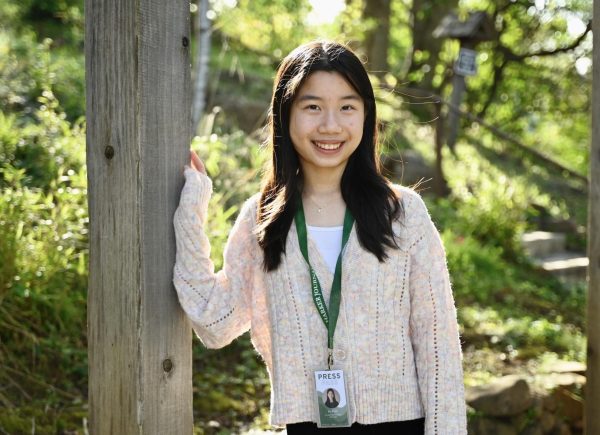
In every interview, I’ve found precious surprises. Beyond the surface, deeper than what can be taken at first glance, we each carry beliefs that shape our stories. Press pass and reporter’s notebook in hand, I search for these hidden sources of wisdom through conversation, whether with student-athletes, school librarians or local restaurant waiters.
Seeing a new side to interviewees impels me to amplify their voices. Journalists build two-way streets — in sharing individual stories, we celebrate the value of unique perspectives while bringing wisdom to our community.
These two-way streets don’t just exist in isolation. They interact and intersect at every step from pitch to publish.
“Our Immigrant Stories,” an investigative package we developed from Jan. to Dec. 2023, encapsulates this synergy. After discussing ideas from grind culture to food waste, our staff chose immigration as our focus topic because of its particular relevance to our school and local community. From there, 19 of us dove into interviewing, photographing, videotaping and designing …
The sheer scale of the project posed a significant challenge. To reach the diversity of sourcing we aimed for and cover ground from historical events to student perspectives, we tackled multiple moving parts simultaneously. Despite planning to publish by June, with each interview, we realized the project was a much larger undertaking. We’d only seen the tip of the iceberg.
As Harker Aquila Co-Editor-in-Chief this year, I led our team of reporters by organizing and compiling “Our Immigrant Stories.” Amidst the flurry of Slack pings, Zoom calls and impromptu meetings in Manzanita 70, there were some moments where I wondered whether we would truly be able to bring the project to fruition.
Yet there were far more moments where I was reaffirmed why “Our Immigrant Stories” mattered. When we presented our initial progress at the JEA/NSPA Spring Convention and asked who could relate to the project, nearly every hand in the room of 200+ student journalists went up. Listening to interview recordings, I gained a deeper understanding of community members I thought I knew well. During team meetings, I saw how many other reporters shared the same enthusiasm. “Our Immigrant Stories” is expansive and complex, but that is also what gives the project deeper meaning.
“Our Immigrant Stories” is about more than just celebrating individual stories. To me, the project exemplifies the importance of journalism: Journalists write stories that create springboards for communities to write their own.
Every interview, article and photo affirms the value of learning about one another. Dear reader, I encourage you to seek out hidden sources of wisdom and pave the two-way streets that allow a community to thrive.


















![“[Building nerf blasters] became this outlet of creativity for me that hasn't been matched by anything else. The process [of] making a build complete to your desire is such a painstakingly difficult process, but I've had to learn from [the skills needed from] soldering to proper painting. There's so many different options for everything, if you think about it, it exists. The best part is [that] if it doesn't exist, you can build it yourself," Ishaan Parate said.](https://harkeraquila.com/wp-content/uploads/2022/08/DSC_8149-900x604.jpg)




![“When I came into high school, I was ready to be a follower. But DECA was a game changer for me. It helped me overcome my fear of public speaking, and it's played such a major role in who I've become today. To be able to successfully lead a chapter of 150 students, an officer team and be one of the upperclassmen I once really admired is something I'm [really] proud of,” Anvitha Tummala ('21) said.](https://harkeraquila.com/wp-content/uploads/2021/07/Screen-Shot-2021-07-25-at-9.50.05-AM-900x594.png)







![“I think getting up in the morning and having a sense of purpose [is exciting]. I think without a certain amount of drive, life is kind of obsolete and mundane, and I think having that every single day is what makes each day unique and kind of makes life exciting,” Neymika Jain (12) said.](https://harkeraquila.com/wp-content/uploads/2017/06/Screen-Shot-2017-06-03-at-4.54.16-PM.png)








![“My slogan is ‘slow feet, don’t eat, and I’m hungry.’ You need to run fast to get where you are–you aren't going to get those championships if you aren't fast,” Angel Cervantes (12) said. “I want to do well in school on my tests and in track and win championships for my team. I live by that, [and] I can do that anywhere: in the classroom or on the field.”](https://harkeraquila.com/wp-content/uploads/2018/06/DSC5146-900x601.jpg)
![“[Volleyball has] taught me how to fall correctly, and another thing it taught is that you don’t have to be the best at something to be good at it. If you just hit the ball in a smart way, then it still scores points and you’re good at it. You could be a background player and still make a much bigger impact on the team than you would think,” Anya Gert (’20) said.](https://harkeraquila.com/wp-content/uploads/2020/06/AnnaGert_JinTuan_HoHPhotoEdited-600x900.jpeg)

![“I'm not nearly there yet, but [my confidence has] definitely been getting better since I was pretty shy and timid coming into Harker my freshman year. I know that there's a lot of people that are really confident in what they do, and I really admire them. Everyone's so driven and that has really pushed me to kind of try to find my own place in high school and be more confident,” Alyssa Huang (’20) said.](https://harkeraquila.com/wp-content/uploads/2020/06/AlyssaHuang_EmilyChen_HoHPhoto-900x749.jpeg)




